INTERPRETATION EQUIPMENT
As seen on TV, at the United Nations, the European Parliament and at the EU, interpretation systems link a speaker using one language to listeners using one or more other languages via interpreters sitting in booths. The multi-lingual interpreters are able to work because they are enabled to listen to the speaker via a microphone system and their interpretation can be received on headsets by listeners using radio or infrared transmission systems or plugged into a cable network.
M&R introduced the original infrared transmission system to the UK short-term hire market in 1979 for use as a simultaneous interpretation system. Infrared is now the accepted industry standard system for 'sim. tran.' systems. |
 |
DELEGATE'S HEADSETS
| Typically each delegate has a headset, comprising a small boxed receiver and light weight headset. Receivers can tune into a range of channels (6 to 16) by using a simple switch and individual volume levels are selected with a gain control. |
| |
 |
|
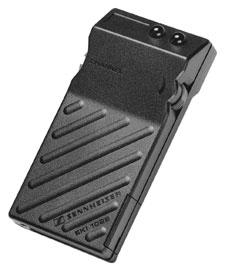 |
CONFERENCE MICROPHONES
Interpretation systems must use microphones to enable the interpreters to follow the proceedings. The microphones can also be used for PA systems and recording the event on audio or video cassettes.
The style of conference or meeting will dictate the range of microphones to be installed, which may be any or a combination of the following :-
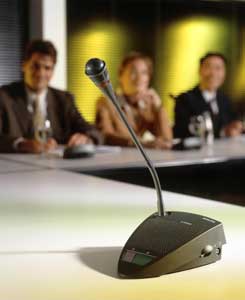 |
- Tie/lapel microphones which allow the wearer to move around with them without being lost to the interpreter.
- Lectern microphones to enable speakers to talk directly to their audience.
- Table microphones which can either be controlled by the system operator or by delegates using push-to-talk microphones.
- Question and Answer microphones which are hand held and can be taken to members of an audience when they want to speak.
- Stand microphones, which are placed around a conference hall for the audience to walk up to when asking questions.
|
TRANSMISSION SYSTEM
 |
M&R use a wireless system which uses the infrared spectrum to transmit audio signals to the delegate receivers. The system behaves like light, reflecting off solid walls and surfaces and traveling through open spaces and transparent materials.
The transmission is distributed from infrared radiators installed round a room on stands or hanging from ceiling bars. The number and positioning of the radiators depends upon the number of channels to be transmitted, the size of the area to be covered and the texture and colour of the walls.
Because of the bandwidth of each channel transmitted, infrared provides true voice reproduction of simultaneous interpreters, speakers and other original sound sources, such as Powerpoint presentations. |
INTERPRETERS BOOTHS AND EQUIPMENT
M&R's interpreter's booths meet with both the ISO standard for portable booths and the requirements of the EU's own interpreters.
The number of Interpretation booths required at any event will depend upon the number of languages to be used and the working method of the team of simultaneous interpreters.
The booths are finished in aluminium and white or aluminium and off white and fit discreetly into most venues. (externally they measure 1.80 X 1.80 X 2M high and 2.50 X 1.80 X 2M high for the EU interpreters)
M&R are not committed to any single range of simultaneous interpretation equipment suppliers and so have selected a range of interpreters consoles, from the DCN industry standard to individual consoles manufactured in-house for very small set-ups. |
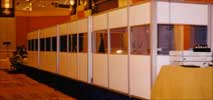
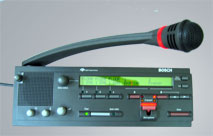 |
THE TECHNICIAN
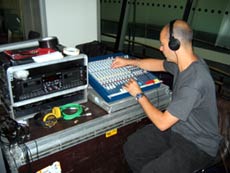 |
M&R technicians lead the installation teams, ensuring that equipment is installed safely, meets the requirements of the clients and is fully tested. During the meeting the technician operates the system to ensure its optimum operation for clear and natural speech. The other important role for the engineer is to facilitate the interface between the interpreters and the organisers and the delegates so that the event runs smoothly. |
SMALLER SIMULTANEOUS TRANSLATION SYSTEMS
While a standard simultaneous translation system with interpreter's booths, full sound system and a technician in attendance is necessary for many events; smaller, simpler interpretation equipment can meet some situations.
For example, round table meetings for a few people, in small rooms but where simultaneous interpreters are needed to ensure the full understanding and involvement in the meeting by all those present. A Forbes or Bidule system can be suitable - no booth, loudspeaker push to talk microphones to enable the interpreters to listen on headphones, a two channel infrared system so that each language group can listen on headsets and an engineer to set up system, start it off with the interpreters and come back to de-rig the system at the end of the meeting. This is applicable only when two languages are involved and the delegates are seated round one table. |
For a Tour Guide system for people on the move click here
SOUND ENHANCEMENT
Simultaneous interpretation systems have to have microphones, so nothing is simpler than adding a loudspeaker system to them, then in addition to having clear, natural speech for the simultaneous interpreters the same quality is heard in the meeting room.
RECORDING THE EVENT
The microphones are part of the 'sim tran' set up so it is no problem to record what is said on the floor or in the booths. This can result in a recording of the floor in the original languages and any or all of the individual languages. (in this case the tape will be in a single language whether it originates from the floor or the booth)
A video recording can also be made, and again the sound track can be in one language or the languages used on the floor. These recordings of the interpreters will usually be used as a rough cut with a final voiceover being used for the final tape.
|